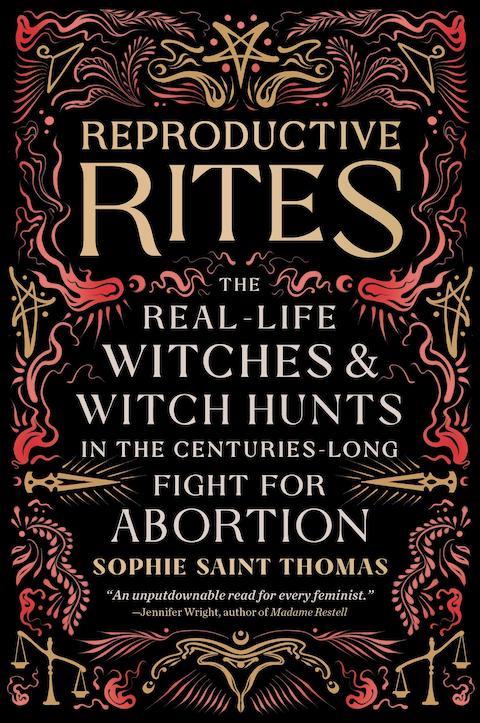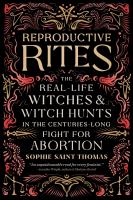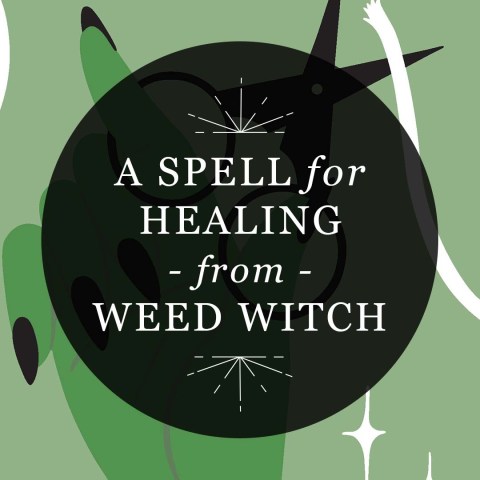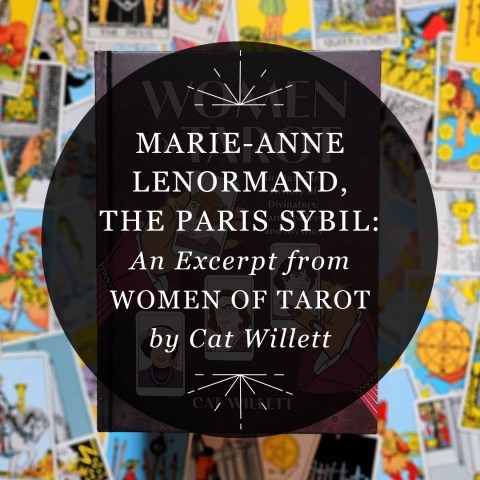Reproductive Rights & Witchcraft in the Middle Ages: Birth Control Icon Béatrice de Planisoles
Dear Mystics, let’s talk about the connection between witchcraft and reproductive justice. Although the phrase “reproductive justice” is relatively new, the fight for women’s rights to control their own bodies is a centuries-long global saga. Journalist and author Sophie Saint Thomas dove into this history immediately after Roe v. Wade was overturned. She found that it is littered with witch hunts of all kinds perpetrated by pharaohs, presidents, religious leaders, white supremacists, and even witches and occultists themselves.
This history is presented, unvarnished and for all to learn from, in Reproductive Rites: The Real-Life Witches and Witch-Hunts in the Centuries-Long Fight for Abortion. Sophie writes in the book’s Introduction: “If I’ve done my job well, this book, like the reproductive justice movement itself, will cater to all: those who have or plan to have children, are unsure, or are resolutely opposed; the agnostic, the devoted Satanist, the witch, or the Christian in search of a compelling history lesson; and people of all genders and sexes—because while cisgender men have caused harm, so have their wives, and we can’t make real progress if we exclude men from the discussions, or if witches continue egregiously branding coven meetings as moon circles and continue to ostracize trans women.”
We asked Sophie which historical icons most inspired her throughout her year of research. Her reply: “Reproductive Rites is filled with icons, but perhaps my favorite from Chapter 2, which focuses on the Middle Ages, is an early advocate of birth control (and getting it on with younger men). Béatrice de Planisoles not only loved bad boys and worshipped the wrong God, but became famous after her sex life landed in the gossip tabloid of the era.”
Enjoy this exclusive excerpt of Reproductive Rites: The Real-Life Witches and Witch-Hunts in the Centuries-Long Fight for Abortion, courtesy of Sophie!

Witches Burn and Inquisitors Babble
Béatrice de Planisoles was born around 1274 and died sometime after 1322, before the plague landed in Europe, but not before she found herself testifying in front of the Inquisition.
Christianity had spread following the era of Cleopatra (shout-out to Charlemagne the Great, the Father of Europe, known for uniting western Europe and then some under what would become the Catholic Church). But five hundred years after Charlemagne, Béatrice’s family still hadn’t made the switch, and her life would be more difficult for that. She was a minor noble and a Cathar, or a frowned-upon brand of Christian that, at the time, was going out of fashion and into flames—literally, on the stake. (A pretty juicy tidbit about Cathars, and the root of their name, is that they allegedly worshipped the devil, who took the shape of a cat.)
Béatrice didn’t love her first husband, Bérenger de Roquefort, even if he came with a castle. But don’t feel bad for her; that’s just how marriages worked for most of history. No matter how much Americans may turn their nose up at arranged marriages in cultures that continue the tradition today, romantic marriages weren’t the norm in the Western world until the eighteenth century. Marriage was a thing your parents arranged for utilitarian reasons, like obtaining land and securing power through family alliances. Accounts paint Béatrice as a Princess Diana–type figure, someone who related most to peasants despite living in a fortress high above them. Plus, Bérenger was not a bad guy—and she would have to deal with plenty of those.
One of the first was Raimond Roussel, the steward of her estate. According to Béatrice’s testimony, Roussel’s preferred form of flirtation seemed to be giving Bérenger shit about God, Béatrice’s body, and her nasty cat-worshipping roots. After she repeatedly declined his offers to leave her family behind—never mind the fact that she was pregnant again with her husband’s child—to live with Roussel and the “good” Christians, one night, by Béatrice’s account:
He entered secretly into my bedroom and hid himself under my bed. I put the house in order and lay down to sleep and when all was quiet and everyone asleep and I myself was sleeping, Raimond came out from under my bed, placed himself next to me and began to act as if he wished to know me carnally. I said “What is this?” He said to be quiet. I replied “What, churl, remain quiet!” and began to cry and call my servants who slept near me in the chamber, saying to them that there was a man in my bed. Hearing this, he left both bed and chamber. The next morning, he said to me that he had done badly to hide himself close to me. I told him “I see now that all your invitations to go to the good Christians are only intended to possess me and sleep with me. If I did not fear that my husband would not believe that I have done nothing dishonest with you, I would send you immediately to the tower dungeon.”
She still stealthily managed to have him fired, even if she spared him the dungeon, and didn’t feel bad about that at all. In fact, it made Béatrice feel so powerful that she bragged about it and asserted that no man would ever cross her again. Sadly for Béatrice, this would come back to bite her.
In 1302, her loveless marriage came to a natural close when Bérenger died. Unfortunately, her mourning attire (required by law), a black dress complete with a veil, did the opposite of deterring her next unwanted pursuer: the villager Pathau Clergue. And, apparently, he either hadn’t heard or didn’t care (or didn’t take Béatrice’s power seriously now that her husband was dead) about what happened to those who came on to her. This one succeeded in raping her. But Béatrice didn’t let him steal her sunshine.
She found happiness and consensual love (or at least lust) with Pathau’s cousin Pierre Clergue, a Cathar priest and a very famous guy in their village. The Clergue family were considered wealthy peasants, and while Pierre was actually born a Catholic, he had inverted the Inquisition’s desired path and converted to Catharism.
By all accounts, Pierre Clergue was that rebellious bad boy—the kind you just can’t help but fall for, even though everyone talks about what a dirtbag he is. He was known for being a scoundrel. He exploited a lovely moral loophole that he created for himself: because everything that’s good is a sin, one might as well sin; and if all sins are equal, why not get your dick wet? In his own words: “One woman’s just like another. The sin is the same, whether she is married or not.” He’d probably be easier to hate if he didn’t end up dead in prison for being a Christian priest of the wrong brand, despite many attempts to bribe and charm his captors. Béatrice’s story has a happier ending than his.
After her love affair with Pierre ended, she remarried another minor noble, named Otho de Lagleize, who died just a few years later. In her postmenopausal years, rather than tuck away into her bedchamber to hide out until death, as was expected, she married a third time. Her third husband was a younger priest, Catholic this time, named Barthélemy Amilhac. Béatrice’s hot young husband was concerned that his wife’s Cathar roots would land both of them in front of the Inquisition, and he was absolutely correct. In the dog days of summer, after being caught with witchy objects in her purse (but let’s be real, more likely for daring to be a hot grandma with a libido), she and Barthélemy both appeared before the infamous bishop Jacques Fournier on charges of blasphemy, witchcraft, and heresy.
You see, she didn’t just like having sex; she was responsible about it. Béatrice practiced birth control—and, depending on which source is telling her story, perhaps even abortion—even if she didn’t know how it worked, thanks to the charismatic but problematic Pierre. Before the plague, and far before the Scientific Revolution, Béatrice lived in a time when the line between birth control and abortion was blissfully blurry. Despite the lack of antibiotics and low-dose hormonal birth control pills, the folks of the Middle Ages had some cards to play that would not fly today. Think about how many advantages a pregnant person who wanted to hide the details of their pregnancy (or its end) had before stethoscopes existed, let alone ultrasound machines or pee-on-the-strip pregnancy tests. For most of history, people found out about a pregnancy only when someone wanted them to, or when it was far too late to conceal, at which point performing a safe and effective abortion was likely out of the question anyway.
Whether you identify with Béatrice in this story or (no judgment) the more problematic Pierre, you can feel good about the fact that the two talked openly about birth control in a conversation that was recorded and lives today in the Vatican’s library, which contains more than one million books.
We know this because she had to tell the whole court in front of the inquisitor, her friends, and her current husband that Béatrice responsibly asked before having sex with Pierre, “What shall I do if I am pregnant by you?” Pierre reassured her that he had an herb that prevented pregnancies. He kept the name of that herb to himself. Pierre gave her choice through birth control, but he did not give her knowledge. It was seen as far too dangerous to let those who can get pregnant hold the knowledge of how to control their own bodies. Or maybe, on a pettier note, Pierre just didn’t want his lover using his birth control methods with his rapist cousin (or anyone other than himself).
It didn’t matter that Béatrice didn’t actually have knowledge of abortive herbs, though, or even those used for birth control, for that matter. Her reputation as a wild woman was enough. She was charged with witchcraft based on what was found in her purse, which included “objects strongly suggestive of having been used by her to cast evil spells.”
These may not have been abortive agents, but they were witchy—and not just a nice piece of rose quartz to sweeten her third marriage. She had spell ingredients that would impress TikTok’s most intimidating Satanic witch today.
Béatrice’s purse contained the two umbilical cords of her grandsons, which she carried to win victory in any lawsuit. (Sadly, the outcome of her story shows us this is not a reliable spell.) She began carrying them after being advised to by a Jewish woman, who was likely a midwife and friend, which didn’t win her any points with Fournier, either. The term “midwife” technically wasn’t even used yet—in France, the word describing such women was often “sage-femme,” referencing both wisdom and the friendly, aptly named herb used for everything from abortive properties to clearance spells.
Béatrice also carried cloth soaked with her daughter’s first period blood, as the same friend said that if the daughter’s husband drinks it, she will maintain his love and loyalty. Ask any self-proclaimed witch today: that spell is legit. In the Voodoo-influenced city of New Orleans, from the time of Marie Laveau to the present, smart men know to avoid drinking coffee served by someone crushing on them, as love and obsession spells are commonly cast by adding brick red period blood to dark beverages such as coffee.
Béatrice must have had a big bag, because her purse also contained frankincense, often used to treat headaches. She also had a mirror; a knife wrapped in linen; a bundle of muslin containing “the seed of the herb ive,” which she claimed was a medicine for her grandson’s epilepsy; and many notes (described as “written formulas”), not unlike your lost grocery lists crumpled in the bottom of your bag.
She also carried arugula—yes, like the salad, a.k.a. Eruca sativa—a popular Middle Ages supplement for enhanced sperm-quality sex drive in men. Given that she was postmenopausal at the time, she was likely carrying it for the latter, making her a fucking icon for investing in her sex life without shame.
Béatrice claimed none of the items were for use in “black” magic, or the kinds of magic that might cause trouble or illness for someone else. But to no end, and it’s no surprise. Throughout history—and often with racist undertones—the powers that be have tried desperately to distinguish between “white” and “black” magic, that is, acceptable forms of practice and unacceptable witchery. But the two go hand in hand. As a woman’s testimony before the Inquisition in Modena in 1499 stated, “Who knows how to heal knows how to destroy.”
Apparently, the only thing that Fournier officially classified as evil was the bread, which was believed to be consecrated in the Cathar faith, thus making her a heretic. Béatrice, along with her hot younger husband, Barthélemy, spent a year in prison. Both were released on July 4, 1322, an independence day of sorts fully 454 years before the United States would claim the date as their own in 1776. At the time, the American colonies were but a twinkle in their European fathers’ eyes. Béatrice, now officially stamped a witch, was sentenced to wear a yellow cross forever on her embroidered clothing as punishment, signifying her Cathar shame; Barthélemy, a Catholic (and, not for nothing, a man), was considered rinsed of his sins after his stint in prison.
So what was the forbidden fruit from the tree of knowledge that could prevent pregnancy? Well, while Pierre kept that info to himself and the records don’t identify it by name, some historians speculate that it could have been a fig, which has a history of use in reproductive rights. Béatrice told the court that “when he wished to ravish me, he carried with him the herb wrapped in linen cloth.” While this seems to indicate a suppository—those controversial pessaries from the previous chapter—there’s a chance that this magic cure-all was actually an amulet, not unlike those imprinted with the head of Sobek, the Egyptian crocodile deity, and exactly as witchy as Catholics continue to be today with their “blood”-drinking rituals.
Béatrice describes the contraceptive in question in her testimony: “It was about an inch wide or long, or about the size of the first joint of my middle finger with a long string that he put around my neck and it descended between my breasts. He always placed it like this when he wanted to make love to me and it remained around my neck until he got up.” A necklace, or a (reusable?) pessary on a string, like a tampon? We may never know. We do know that individualists like Béatrice provided the tabloids of the time with the image that would become synonymous with witches: an older woman (perhaps a cat owner) who doesn’t fit in with society—and maybe even gets around on a broom.











